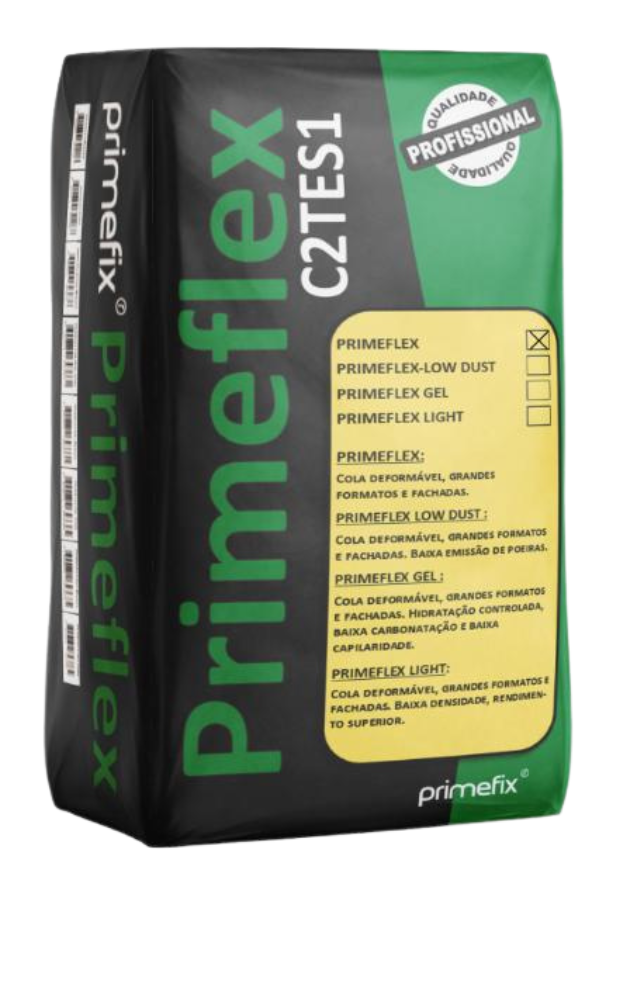Prime flex
Classification Type C2TE S1
Cementitious adhesive for tiles and stone, type C2TES1, applicable for bonding ceramic flooring and coverings and stone materials up to large formats.
Packaging
25Kg paper bags
1400Kg pallet (56 units)
Color
White
Gray
Description
Cementitious adhesive for tiles and stone, type C2TES1, applicable for bonding ceramic flooring and coverings and stone materials up to large formats (with and without absorption), indoors and outdoors. Recommended for facades .
Properties
Deformable cementitious adhesive, with extreme adhesion, excellent workability, extended open time and reduced slippage.
Composition
Mixed binder cement adhesive composed of cement, special resins, mineral fillers and specific additives.
Support
Cement-based substrates: screed, sanded plaster or concrete; Bonding ceramic tiles on waterproofing systems (subject to compatibility analysis); Bonding ceramic tiles on ceramic tiles indoors; Bonding ceramic tiles and natural stone on underfloor heating; Bonding ceramic tiles on external thermal insulation systems _ETICS (height limited); Bonding thermal insulation panels, such as EPS/XPS (without film)/ICB on milled ceramic tiles (with the glass removed), outdoors; Bonding large-format ceramic tiles and natural stone (deformable). Bonding ceramic tiles on waterproof plasterboard panels. Bonding can be carried out on other substrates indoors, such as: OSB (Oriented Strand Board), composite cement and wood panels, plasterboard and paint, by applying Primecryl-Plus primer. Wait at least 24 hours and then bond the ceramic tiles. In an outdoor environment, an analysis of the existing conditions is required. For other substrates, please consult Primefix. Conditional bonding on other supports, using Primecryl-Plus primer.
Application instructions
Aplicação geral:
- Knead Primeflex with 6.5 liters to 6.75 liters of clean water (per 25 kg bag of powder) manually or with a slow electric mixer, until you obtain a consistent, homogeneous dough without lumps;
- Let the dough rest for 2 minutes before applying, and then mix lightly;
- Apply the glue to the support in small areas, no more than 1 m2 to 1.5 m2 , using a notched trowel;
- Press and adjust the ceramic pieces to obtain continuous and complete adhesion of the glue;
- Periodic checking of the glue distribution on the part is recommended;
- In the presence of poor distribution, use the double gluing method and/or a trowel with a higher tooth.
- Limit single gluing to the maximum dimension of the pieces of 35 cm x 35 cm. Above this dimension, double gluing is recommended;
- Recommended layer thickness: 6 mm; Maximum layer thickness: 8 mm;
- Avoid placing wet items;
- Check the cleanliness of the back of the parts to be glued;
- Respect the fractionation/construction joints, using technical profiles or mastics, which allow the absorption of tensions;
- When placing ceramic tiles between 2 parallel boundaries (e.g. a corridor) there must be clearance between the end of the ceramic tiles and the obstacle or vertical slope;
- Use spacing crosspieces, at least 2 mm for small formats, gradually increasing as the size of the piece increases;
- Scrape and clean the joint before the glue hardens;
- Avoid adding product and/or water to the already mixed glue, particularly when it reaches the hardening process;
- On facades, the act of gluing/installing ceramic coating is limited to a wind speed of less than 30 km/h.
- Respect the recommendations for applying the ETICS System on MILLED ceramics defined in the Technical Data Sheets and Application Manuals.
Grouting of Joints:
- You can carry out grouting after a minimum waiting period of 48 hours.
- In closed, unventilated areas and on low-absorption substrates, extend the waiting time to 72 hours.
- Make sure there is no moisture.
- You can grout the joints with Primecolour mortar that is most suitable for the application.
Bonding ceramics on the ETIC'S system:
- Reinforce the insulating plate busbar with 2 layers of fiberglass mesh + multi-busbar.
- When gluing ceramic/stone pieces, it is recommended to limit the height:
- Apply ceramic protection to the lower part of the walls, at half height (1.5m).
- We recommend that the ceramic tile is not glued more than 3m from the floor of areas where users circulate or spend time (terraces, balconies, streets, corridors).
Laying Natural Stone (non-resistant slabs):
- The maximum height of application using only gluing must not exceed 3 m in relation to the floor of areas where users circulate or remain (terraces, balconies, streets, corridors);
- Characterization of stone plates:
- Nature of the stone: natural stones present significant dimensional variations and warping depending on the humidity and thermal gradients to which they are subjected. Gluing is only recommended for serpentine, granite, limestone (moleanos/Moca) and some marbles. Other stones, such as: Slate, schist, green marble, require exposure analysis and it is recommended to carry out gluing plus mechanical fixing.
- The mass of the plates must not exceed 40 kg/m 2 ; ÞThe largest dimension of the plates must not exceed 600 mm; ÞThe surface of the plates must not exceed 0.24 m 2 ;
- The planimetry deviation must not exceed 0.2% of the length of the part.
- Limit the thickness of the plates between 15 mm and 20 mm;
- For larger formats, use the joint gluing and mechanical fixing system without embedding – visible nail anchors (hidden nail anchors require plate thicknesses greater than 20 mm), which allow the plate and support to be deformed simultaneously. These must be made of stainless steel with a Teflon coating in the contact area;
- The supporting plaster mortar must have a minimum compressive strength of class CS IV, with adhesion ≥ 0.5 MP A and flexural strength ≥ 2.5 MP A. It must be at least 30 days old;
- Make horizontal and vertical elastic joints in lintels, balconies and window sills. In running cloth, horizontal elastic joints every 3 m with 10 mm thickness and vertical elastic joints every 6 m with 8 mm thickness;
- Joints between parts are at least 4 mm thick;
- When changing direction, if the pieces overlap at the corner, then leave a joint of at least 5 mm;
- Carry out a visual inspection of all plates and remove those with nodules and defects, cracks and warps (maximum 3 mm in 2 m).
Technical Data
|
Application: |
Indoor/Outdoor |
|---|---|
|
Application temperature: |
5º C to 30º C |
|
Recommended layer thickness: |
6 mm |
|
Open time: |
> 30 minutes |
|
Adjustability time: |
25 minutes |
|
Occasional pedestrian passability |
72 hours |
|
Commissioning time: |
15 days (depending on the nature of the tiles/support and the existing conditions) |
|
Usage time for fresh mortar: |
2 hours (depending on environmental conditions) |
|
Rest time before starting application: |
5 minutes |
|
Mixing Ratio: |
260 ml to 270 ml of water / Kg of powder |
|
Consumption: |
Single gluing: 4 to 5 kg/ m2 ; |
|
Double gluing: |
5 to 8 kg/ m2 . |
|
Packaging: |
25 kg paper bags – Pallet of 56 x 25 kg bags (1400 kg) |
|
Cleaning: |
Water |
|
Storage: |
1 year from the date of production, in closed original packaging and protected from heat and humidity. |
CE Marking Data
|
Reaction to fire (Organic matter < 20%): |
Class E |
|---|---|
|
Initial tensile bond strength |
≥ 1.0 MPA |
|
Tensile bond strength after water immersion |
≥ 1.0 MPA |
|
Tensile bond strength after heat aging |
≥ 1.0 MPA |
|
Tensile bond strength after Freeze-Thaw cycles |
≥ 1.0 MPA |
|
Open Time: Tensile bond strength after not less than 30 minutes |
≥ 0.5 MPA |
|
Slippage |
≤ 0.5 mm |
|
Transverse deformation |
≥ 2.5 mm and < 5 mm |
Receive additional information






